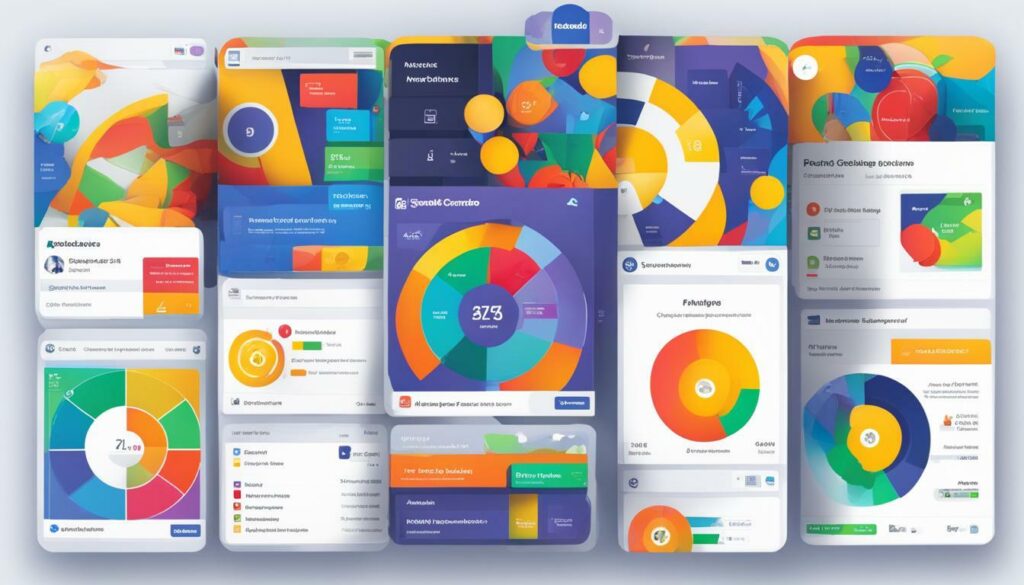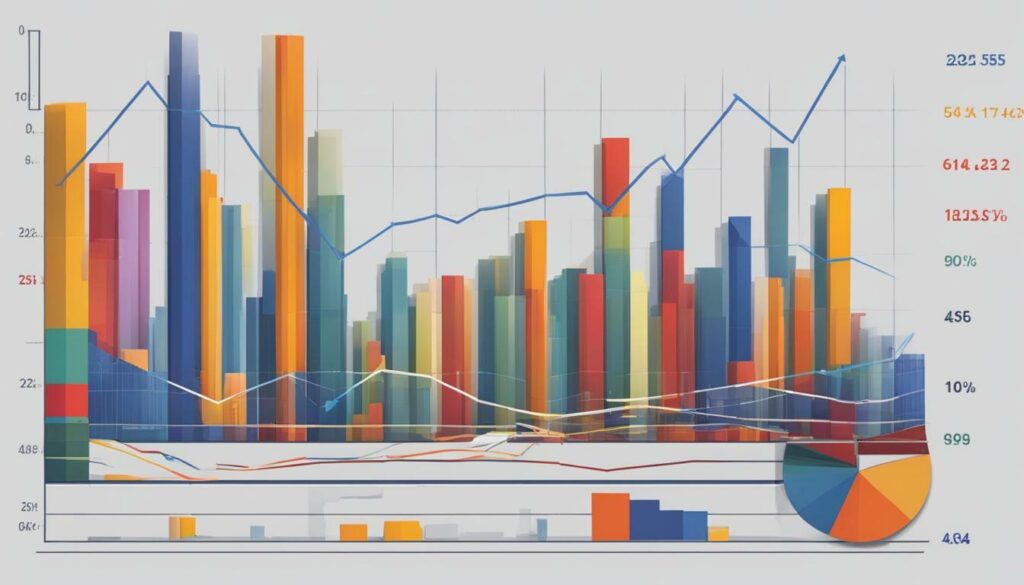In today’s digital landscape, choosing the best size for your Facebook ads is crucial to unlocking success and maximizing your online exposure and engagement. With countless potential viewers scrolling through their Facebook feeds every day, it’s essential to capture their attention with visually appealing and properly formatted ads.
Key Takeaways:
- Choosing the optimal dimensions for your Facebook ads can greatly impact their performance.
- Recommended Facebook ad sizes include at least 1080 x 1080 pixels with a 1.91:1 to 1:1 aspect ratio.
- JPG or PNG files are the recommended file types for Facebook ad images.
- Ad copy should be concise, with a primary text limit of 125 characters and a headline limit of 27 characters.
- Utilizing Facebook Ads Manager and its various features can enhance your advertising efforts and improve campaign results.
Understanding Facebook Ads Manager
Facebook Ads Manager is a powerful tool that can elevate your digital marketing efforts and drive exceptional results for your campaigns. With its extensive range of features and functionalities, it provides advertisers with the ability to create, manage, and optimize their Facebook ad campaigns effectively.
One of the key advantages of using Facebook Ads Manager is its versatility in catering to various advertising objectives. Whether you aim to increase brand awareness, drive website traffic, generate leads, promote your app, or boost sales, Facebook Ads Manager offers a range of campaign objectives to suit your specific goals.
Navigating the Ads Manager Dashboard allows you to seamlessly manage multiple campaigns, ad sets, and ads in one centralized location. The user-friendly interface provides access to essential metrics, performance data, and insights, enabling you to monitor and analyze the effectiveness of your campaigns in real-time.
Ads Manager vs. Boosted Posts
It is important to differentiate between Ads Manager and Boosted Posts. While Boosted Posts allow you to promote individual Facebook posts directly from your business page, Ads Manager provides a more comprehensive and strategic approach to managing your advertising efforts.
With Ads Manager, you have greater control over your campaigns, including advanced targeting options, customizable ad sets, and budget optimization. Additionally, Ads Manager offers a wide range of ad formats, such as image ads, video ads, carousel ads, and more, allowing you to tailor your ads to engage and resonate with your target audience.
By utilizing Facebook Ads Manager, you can unlock the full potential of your digital marketing efforts and maximize the impact of your Facebook ad campaigns.
| Benefits of Facebook Ads Manager |
|---|
| Centralized campaign management |
| Advanced targeting options |
| Customizable ad formats |
| Real-time performance monitoring |
With these features and the ability to create highly targeted and engaging ads, Facebook Ads Manager is an essential tool for any digital marketer looking to drive success in their advertising efforts.

In conclusion, mastering Facebook Ads Manager is crucial for unlocking success in your digital marketing campaigns. By understanding its features, utilizing advanced targeting options, and leveraging customizable ad formats, you can optimize your ad performance and maximize your results. Start harnessing the power of Facebook Ads Manager today and take your advertising efforts to new heights.
Understanding how to navigate the Ads Manager dashboard is essential for harnessing the full potential of Facebook Ads and maximizing the effectiveness of your advertising campaigns. The Ads Manager dashboard is a powerful tool that provides a comprehensive overview of your campaign performance, audience insights, and ad creation options. Let’s explore the key features and functionalities of the Ads Manager dashboard:
1. Campaign Overview
In the Campaign Overview section, you’ll find a summary of your active campaigns, including key metrics such as reach, impressions, clicks, and conversions. This gives you a quick snapshot of your campaign performance and allows you to track the success of your advertising efforts at a glance.
2. Ad Sets and Ad Creatives
The Ad Sets and Ad Creatives sections allow you to manage and optimize your ads. Here, you can create and edit ad sets, select your target audience, and customize your ad creative. You can also A/B test different ad variations to determine which ones perform best and make data-driven decisions to improve your campaign results.
3. Audience Insights
The Audience Insights feature provides valuable information about your target audience, including demographics, interests, and behaviors. This data enables you to refine your targeting strategy, ensuring that your ads are reaching the right people and maximizing engagement.
4. Reports and Analytics
Facebook Ads Manager offers robust reporting and analytics tools to measure the performance of your campaigns. You can access detailed reports on key metrics, such as impressions, clicks, conversions, and cost per result. These insights allow you to identify trends, optimize your ad strategy, and make informed decisions to drive better results.
By familiarizing yourself with the Ads Manager dashboard and its various features, you can navigate through the platform with ease and leverage its capabilities to enhance your advertising efforts. With proper navigation, you can optimize your campaigns, reach your target audience effectively, and achieve your advertising goals on Facebook.
Remember to regularly monitor and analyze your campaign performance, make data-driven adjustments, and stay up to date with the latest Facebook Ads Manager updates and best practices to stay ahead in the dynamic world of digital advertising.
Creating Your First Campaign: Step-by-Step Guide
Creating a successful Facebook ad campaign requires careful planning and execution. Follow this step-by-step guide to ensure your campaign reaches the right audience and achieves your marketing objectives.
Step 1: Setting Campaign Objectives
Before diving into creating your Facebook ad campaign, it’s essential to define your campaign objectives. Facebook offers various campaign objectives such as awareness, consideration, and conversion. Choose the objective that aligns with your marketing goals, whether it’s increasing brand awareness, driving traffic to your website, or generating leads.
Step 2: Defining Target Audience
Next, identify your target audience. Define their demographics, interests, and behaviors to ensure your ads are shown to the right people. Facebook’s Audience Insights tool can help you gain insights into your target audience’s characteristics and preferences, allowing you to tailor your ad content accordingly.
Step 3: Ad Placements and Budget Allocation
Decide on the ad placements that best suit your campaign objectives. Facebook offers a variety of placements, including the news feed, Instagram feed, and audience network. Consider your target audience’s browsing habits and preferences when selecting the placements.
Step 4: Crafting Compelling Ad Creative
Now it’s time to create your ad creative. Choose the appropriate ad format, whether it’s a single image, video, carousel, or slideshow. Ensure your ad copy is captivating and concise, grabbing the viewer’s attention and clearly conveying your message. Use design tips such as vibrant visuals and clear call-to-actions to maximize the impact of your ad.
| Ad Format | Recommended Dimensions | File Size Limit |
|---|---|---|
| Single Image | 1080 x 1080 pixels | 30MB |
| Video | 1:1 aspect ratio | 4GB |
| Carousel | 1080 x 1080 pixels | 30MB |
“Creating a successful Facebook ad campaign requires careful planning and execution. Follow this step-by-step guide to ensure your campaign reaches the right audience and achieves your marketing objectives.”
Step 5: Optimizing Ad Performance
Continuously monitor and optimize your ad performance to maximize results. Utilize ad sets for better organization and control over your campaigns. Experiment with advanced targeting options such as custom audiences and lookalike audiences to reach a more relevant audience.
By following these steps, you’ll be well on your way to creating successful Facebook ad campaigns that effectively engage your target audience and drive meaningful results.
Note: The specifications provided in the table are for reference only. It’s important to stay up-to-date with Facebook’s latest ad specifications and guidelines for optimal ad performance.
Crafting Compelling Ad Creative
Captivating ad creative is the key to capturing the attention of your audience and driving engagement. Learn how to craft compelling ad creative that stands out on Facebook.
When it comes to creating ad creative for Facebook, it’s important to consider the different ad formats available. Facebook offers a variety of options, including image, video, carousel, and slideshow ads. Each format has its own strengths and can be used to convey different messages effectively. For example, image ads are great for showcasing a single product or service, while video ads can tell a story and engage viewers with movement and sound.
When crafting ad copy, keep in mind that you have limited space to capture your audience’s attention. Use compelling headlines and concise descriptions to quickly convey the value of your offer. With a character limit of 125 characters for the primary text and 27 characters for the headline and description, every word counts. Make sure your copy is clear, engaging, and persuasive.
Design plays a crucial role in the success of your ad creative. Use high-resolution images or videos that are visually appealing and relevant to your message. Facebook recommends using a minimum image size of 1080 x 1080 pixels and an aspect ratio of 1.91:1 to 1:1 for image ads. Additionally, videos should have an aspect ratio of 1:1 for desktop or mobile and 4:5 for mobile-only ads. It’s also important to consider file types, maximum file size, and aspect ratio tolerance to ensure your ad creative meets Facebook’s specifications.
“Design is not just what it looks like and feels like. Design is how it works.” – Steve Jobs
Ad Creative Best Practices
- Know your target audience: Understanding your audience’s needs, preferences, and motivations will help you create ad creative that resonates with them.
- Keep it simple: Avoid cluttering your ad with too much information. Focus on a clear message and a single call-to-action.
- Test and iterate: Continuously test different creative elements, such as headlines, images, or videos, to optimize your ad performance.
- Use strong visuals: Eye-catching visuals can grab attention and make your ad stand out in a crowded feed.
- Include a clear call-to-action: Clearly communicate the desired action you want your audience to take, whether it’s to visit your website, make a purchase, or sign up for a newsletter.
By following these best practices and customizing your ad creative to fit your target audience and campaign objectives, you can create compelling ads that drive results on Facebook.

| Recommended Image Dimensions | Recommended Video Dimensions |
|---|---|
| Minimum Resolution: 1080 x 1080 pixels Aspect Ratio: 1.91:1 to 1:1 File Type: JPG or PNG Maximum File Size: 30MB |
Aspect Ratio: 1:1 for desktop or mobile, 4:5 for mobile-only ads Minimum Resolution: 120 x 120 pixels File Types: MP4, MOV, or GIF Maximum File Size: 4GB |
Optimizing Ad Performance: Ad Sets and Targeting
To maximize the performance of your Facebook ads, it is crucial to optimize your ad sets and utilize advanced targeting options. Discover how to leverage these strategies to reach the right audience and achieve your advertising goals.
When it comes to Facebook advertising, ad sets play a crucial role in organizing your campaigns and targeting specific audiences. Ad sets allow you to group your ads together and tailor them to different demographics, behaviors, and interests. By optimizing your ad sets, you can ensure that your ads are shown to the most relevant audience, increasing the likelihood of engagement and conversions.
One powerful tool in Facebook Ads Manager is the ability to create custom audiences. These audiences are created based on various criteria, such as website visitors, app users, or customer lists. By targeting these custom audiences, you can deliver personalized ads to people who have already shown an interest in your business, increasing the chances of conversion. Additionally, utilizing lookalike audiences can help you expand your reach by finding users who share similar characteristics to your existing customers or website visitors.
Table 1: Facebook Ad Targeting Options
| Targeting Option | Description |
|---|---|
| Demographics | Targeting users based on age, gender, location, language, and more. |
| Interests | Targeting users based on their interests, hobbies, and pages they like. |
| Behaviors | Targeting users based on their online and offline behaviors, such as purchase history, device usage, and travel preferences. |
| Custom Audiences | Targeting users who have interacted with your business in some way, such as website visitors, app users, or customer lists. |
| Lookalike Audiences | Targeting users who share similar characteristics to your existing customers or website visitors. |
By combining these targeting options with effective ad creative, you can create highly personalized and engaging ads that resonate with your target audience. Remember to continuously monitor and analyze the performance of your ads using Facebook Ads Manager’s analytics and metrics. This will allow you to identify what is working well and make data-driven optimizations to improve your ad performance.
By optimizing your ad sets and utilizing advanced targeting options, you can unlock the full potential of Facebook advertising and maximize your results. Follow these strategies and continuously test and refine your campaigns to achieve your advertising goals and drive exceptional success in your Facebook ad campaigns.

Table 1 provides a summary of the various targeting options available in Facebook Ads Manager. By utilizing these options effectively, you can narrow down your audience and ensure that your ads are shown to the most relevant users, increasing the chances of engagement and conversions.
Remember, optimizing your ad performance is an ongoing process. Continuously experiment with different ad sets and targeting options, analyze the results, and make data-driven decisions to optimize your campaigns. With the right approach, you can unlock the full potential of Facebook advertising and achieve exceptional results for your business.
Best Practices for Image and Video Ads
Follow these best practices to create visually appealing image and video ads that grab the attention of your target audience and drive results on Facebook.
Design Recommendations
When it comes to image ads on Facebook, it’s important to pay attention to the following design recommendations:
| File Type | Ratio | Resolution |
|---|---|---|
| JPG or PNG | 1.91:1 to 1:1 | At least 1080 x 1080 pixels |
| Text Recommendations | ||
| Primary Text | 125 characters | |
| Headline | 27 characters | |
| Description | 27 characters | |
| Technical Requirements | ||
| Maximum File Size | 30MB | |
| Minimum Width | 600 pixels | |
| Minimum Height | 600 pixels | |
| Aspect Ratio Tolerance | 3% |
Facebook Video Ads
When creating video ads for Facebook, consider the following specifications:
- Recommended Facebook ad aspect ratio: 1:1 for desktop or mobile, 4:5 for mobile-only ads. Ratios from 16:9 to 9:16 are supported, but they may be masked to 4:5 on mobile.
- Minimum Facebook ad dimensions: 120 x 120 pixels.
- Recommended Facebook video ad format: MP4, MOV, or GIF.
- Maximum file size: 4GB
- Facebook video ad size (resolution): The best size for a Facebook ad is at least 1080 x 1080 pixels, but it’s best to use the highest resolution that meets the ratio requirements since there is no maximum resolution.
- Video Settings: H.264 compression, square pixels, fixed frame rate, progressive scan, and stereo AAC audio compression at 128kbps+.
- Video duration: Between 1 second and 241 minutes.
- Captions and sound: Captions are optional but recommended because many people watch videos without sound. However, adding sound to your video is still recommended.
Instagram Image Ads
For Instagram image ads, keep the following specifications in mind:
| Recommended resolution | Recommended image ratio | Aspect ratio tolerance | Minimum width |
|---|---|---|---|
| At least 1080 x 1080 pixels | 1:1 | 1% | 500 pixels |
| Maximum file size | 30MB | ||
| Aspect ratio | From 400 x 500 to 191 x 100. | ||
| Recommended file types | JPG or PNG |
By adhering to these best practices and following the recommended image and video ad specifications, you can create visually stunning ads that capture the attention of your target audience, maximize engagement, and drive results on Facebook.
Measuring and Optimizing Ad Performance
Monitoring and optimizing the performance of your Facebook ads is essential for achieving your marketing objectives. Learn how to measure and optimize your ad performance using Facebook Ads Manager’s robust analytics and metrics.
Facebook Ads Manager provides a wealth of data and insights to help you track the effectiveness of your ad campaigns. By analyzing key metrics, you can identify areas of improvement and make data-driven decisions to optimize your ad performance.
Key Metrics for Ad Performance Measurement
When measuring the performance of your Facebook ads, there are several important metrics to consider:
- Reach: The number of unique users who see your ad
- Impressions: The total number of times your ad is displayed
- Click-through rate (CTR): The percentage of users who click on your ad
- Conversion rate: The percentage of users who complete a desired action, such as making a purchase or filling out a form
- Cost per click (CPC): The average amount you pay for each click on your ad
- Return on ad spend (ROAS): The revenue generated for every dollar spent on ads
By regularly monitoring these metrics, you can gain valuable insights into the performance of your ads and make data-driven optimizations to improve their effectiveness.
Optimizing Ad Performance
Once you have analyzed the performance metrics of your Facebook ads, it’s time to take action to optimize their performance. Here are some strategies to consider:
- Adjust your targeting: Review your target audience settings and refine your targeting criteria to reach the most relevant audience for your ads.
- Test different ad variations: Create multiple versions of your ad with different elements, such as headlines, images, or calls-to-action, and test them against each other to identify the most effective combination.
- Optimize your bidding strategy: Experiment with different bidding strategies, such as manual bidding or automatic bidding, to find the approach that delivers the best results for your campaign goals.
- Utilize remarketing: Target users who have previously interacted with your ads or website, as they are more likely to convert into customers.
By continually monitoring and optimizing your Facebook ad performance, you can maximize your return on investment and achieve your marketing goals more effectively.
| Metric | Definition |
|---|---|
| Reach | The number of unique users who see your ad |
| Impressions | The total number of times your ad is displayed |
| Click-through rate (CTR) | The percentage of users who click on your ad |
| Conversion rate | The percentage of users who complete a desired action, such as making a purchase or filling out a form |
| Cost per click (CPC) | The average amount you pay for each click on your ad |
| Return on ad spend (ROAS) | The revenue generated for every dollar spent on ads |
By focusing on these metrics and implementing optimization strategies, you can continually improve the performance of your Facebook ads and drive better results for your business.
Remember, measuring and optimizing your ad performance is an ongoing process. Regularly analyze your metrics, test different approaches, and make data-driven adjustments to maximize the effectiveness and ROI of your Facebook ad campaigns.

Conclusion
Choosing the best size for your Facebook ads is a critical factor in unlocking success and maximizing your results. By following the strategies outlined in this guide, you can ensure that your ads make a lasting impact and drive exceptional results for your business.
Facebook Ads Manager is a powerful tool that can significantly elevate your advertising efforts. Understanding its features and functionalities is essential for creating effective campaigns that reach your target audience.
In this comprehensive guide, we have covered everything you need to know about Facebook Ads Manager, from navigating the dashboard to creating your first campaign. We have discussed the importance of crafting compelling ad creative and optimizing ad performance through ad sets and advanced targeting options.
Additionally, we have provided best practices for image and video ads, ensuring that your visuals meet the recommended specifications for optimal performance. Measuring and optimizing ad performance is also crucial, and we have shared tips on leveraging analytics and metrics to improve your campaigns.
Now armed with this knowledge, it’s time to implement these strategies in your own Facebook advertising campaigns. Choose the best size for your ads, create compelling ad creative, and continually optimize your performance to unlock success and maximize your results. Get started today and see the impact it can have on your business!
FAQ
Q: What are the recommended image sizes for Facebook ads?
A: The best size for a Facebook ad is at least 1080 x 1080 pixels, with a ratio of 1.91:1 to 1:1. It’s recommended to use the highest resolution that meets the ratio requirements. The minimum dimensions are 600 x 600 pixels and the maximum file size is 30MB.
Q: What are the recommended image sizes for Instagram ads?
A: For Instagram ads, the recommended resolution is at least 1080 x 1080 pixels, with a ratio of 1:1. Image ratios from 16:9 to 9:16 are supported, but your image may be masked to 1:1. The minimum width is 500 pixels and the maximum file size is 30MB.
Q: What are the recommended video sizes for Facebook ads?
A: Facebook video ads should have an aspect ratio of 1:1 for desktop or mobile, and 4:5 for mobile-only ads. Ratios from 16:9 to 9:16 are supported, but they may be masked to 4:5 on mobile. The recommended resolution is at least 1080 x 1080 pixels, and the maximum file size is 4GB.
Q: What are the recommended video sizes for Instagram ads?
A: The recommended video size for Instagram ads is at least 1080 x 1080 pixels, with an aspect ratio of 4:5. Ratios from 1.91:1 to 4:5 are supported, and the minimum width is 500 pixels. The maximum file size is 250 MB.
Q: What are the character limits for Facebook ad text?
A: The primary text can have up to 125 characters, with the rest of the text visible when the viewer clicks “See More.” The headline has a limit of 27 characters, and the description also has a limit of 27 characters. However, you can exceed these limits, but the text may be truncated.
Q: What are the character limits for Instagram ad text?
A: The primary text for Instagram ads can have up to 125 characters, with the additional text revealed when the viewer clicks “more.” The headline has a limit of 40 characters, and up to 30 hashtags are allowed.
Hi there, I'm Jacqueline! Passionate about the ins and outs of Facebook, I created this blog to be your go-to resource for mastering ad campaigns, community engagement, and algorithm hacks. Looking to make your Facebook efforts truly 'Like'-worthy? You're in the right place. Let's elevate your social impact together!




